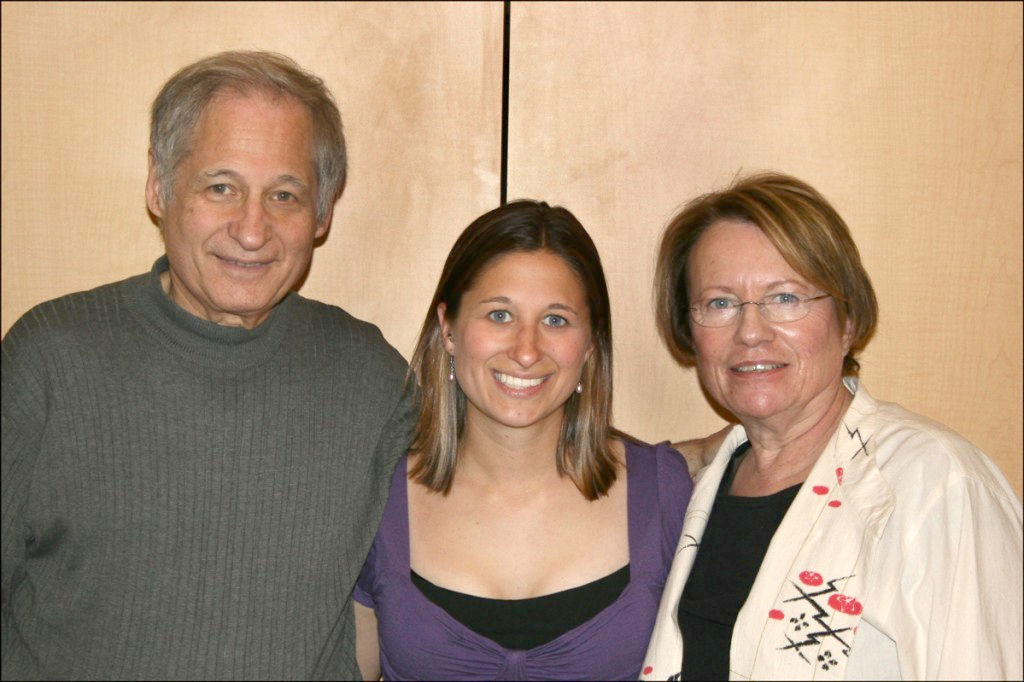Today, Steve Morse and his daughter Megan presented a lecture on DNA at the California Genealogical Society and Library in Oakland, California.
SOURCE: Steve, Megan, and Anita Morse (Oakland, Alameda County, California). Photographed by Stephen J. Danko on 13 June 2009.
The lecture was entitled “From DNA to Genetic Genealogy: Everything You Wanted to Know but Were Afraid to Ask” and was a basic introduction to the use of DNA for genealogical purposes. Steve’s approach to this lecture was similar to his approach to other endeavors in which he has been involved – fulfilling an unmet need. His One-Step webpages fulfill the need for a better way to search for information such as the Ellis Island Passenger Manifests or the US Federal Censuses. This lecture fulfilled the need for basic information on DNA for those who know little or nothing about DNA, but want to understand how DNA analysis can be useful in genealogical studies.
Steve’s lecture covered the fundamentals of DNA: traits are determined by genes located on chromosomes which are composed of DNA. He briefly reviewed the discovery of genes and DNA, and described how the sequence of bases in DNA describes the sequence of amino acids in proteins. Finally, he described how analysis of DNA can be used in genealogical research.
When passed down from parents to their children, the DNA that comprises most chromosomes, the 22 pairs of autosomal chromosomes, is shuffled like a deck of cards. Because of this shuffling, the autosomal chromosomes are of limited value in genealogical research.
The two chromosomes that have been used most for genetic genealogy are the Y chromosome, passed down from father to son, virtually unchanged, and the mitochondrial chromosome, passed down from mother to her sons and daughters, again virtually unchanged.
Still, errors in copying the DNA result in two types of mutations that genetic genealogists can use to study their genetic ancestry. These errors are SNiPs (more commonly referred to as SNPs), single nucleotide polymorphisms which are changes in a single base in the DNA, and STiRs (more commonly referred to as STRs).
By analyzing the SNiPs and STiRs, genetic genealogists have been able to construct genetic family trees and follow ancient migration patterns of humans out of Africa.
Steve also showed how DNA analysis can be used to trace the lineages of Jewish High Priests (the Kohanim), and how DNA analysis can be used to understand how genetic diseases are transmitted.
Steve’s daughter Megan holds a degree in Evolution and Ecology and is employed as an animal handler and wildlife educator at Wildlife Associates in Half Moon Bay, California. In her portion of the lecture, she described how DNA codes for traits that determine survival. Megan explained the concepts of evolution and natural selection, and further explained how changes in the DNA can result in the establishment of new species.
Megan also introduced the audience to an opossum she brought with her and discussed some of the notable traits of the opossum, including the 50 teeth, the nocturnal habit, the semi-prehensile tail, the opposable thumb, and the ability of the opossum to “play dead”, all of which are determined by the opposum’s DNA. She ended her part of the lecture with three of the most profound words I’ve ever heard spoken in connection with genetic genealogy: “Genealogy is evolution”.
Steve wrote an article on DNA for the Association of Professional Genealogists Quarterly, upon which his lecture is based. The article is available through his website: http://www.stevemorse.org.
Copyright © 2009 by Stephen J. Danko




